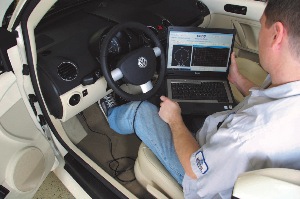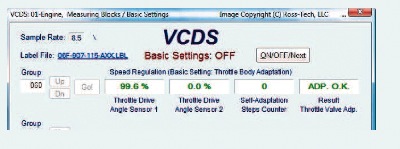Since 1996, most gasoline-engine VAG cars have electrically controlled throttles.
Have you had a customer pull into the shop with a Volkswagen or Audi that just will not idle correctly? One of the possible causes is that the throttle position is not known. The ECU must know the full range of motion of the throttle in order for it to properly control the engine.
When the motion range is not known, the ECU simply has no idea where to set the throttle. Using the throttle position sensors in the throttle body, the ECU learns the full open and full closed positions through a process known as a Throttle Body Alignment (TBA).
A TBA needs to be performed whenever one of the following occur:
• Loss of voltage to the vehicle (battery disconnected or battery run down to low voltage);
• ECU has been disconnected, reconnected or replaced;
• Throttle body has been cleaned, removed or
re-installed; or
• Accelerator pedal has been removed or
re-installed.
There are certain operating conditions that must be met before the throttle is adapted. These include:
• No DTCs in the engine controller;
• Battery voltage is at least 11.5V;
• The throttle should be at the idling position (keep your foot off the accelerator pedal);
• The throttle body must not be dirty (carbonized); and
• The coolant temperature must be between 5° C and 95° C.
In the example shown here, the VCDS factory-level tool is used to perform the procedure. See Fig. 1.
Note: Other factory-level tools may require slightly different procedures, but should be very similar.
This procedure is performed with the key on, engine off and without touching the accelerator pedal.
Procedure for performing the TBA on DBW cars that use KWP-2000 (typical of engine controllers in 2002+ Audi A4, VW Passat and Touareg):
[Select]
[01– Engine]
[Basic Settings—04]: Group 060
[Go!] “Basic Settings: OFF” will appear under the VCDS logo. See Fig. 2.
[ON/OFF/Next] will switch “Basic Settings: ON” under the VCDS logo. The display will show ADP RUN and the throttle will begin to cycle. Leave the tool in basic settings for 30 seconds after the display shows ADP OK.
Then click: [Done, Go Back]
Courtesy of Ross-Tech.













